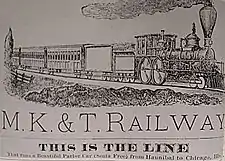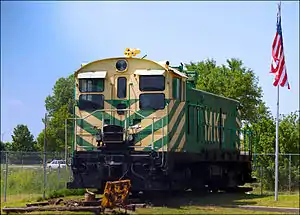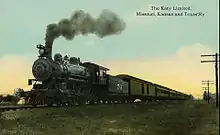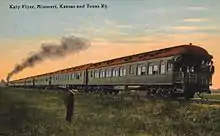Missouri–Kansas–Texas Railroad
The Missouri–Kansas–Texas Railway (reporting mark MKT) is a former Class I railroad company in the United States, with its last headquarters in Dallas. Established in 1865 under the name Union Pacific Railway, Southern Branch, it came to serve an extensive rail network in Texas, Oklahoma, Kansas, and Missouri. In 1988, it merged with the Missouri Pacific Railroad; today, it is part of Union Pacific Railroad.
 | |
.svg.png.webp) Katy system as of 1918; many of the outlying lines left the system in the 1923 reorganization | |
| Overview | |
|---|---|
| Headquarters | Dallas, Texas |
| Reporting mark | MKT |
| Locale | Kansas, Missouri, Oklahoma, and Texas |
| Dates of operation | 1870–1988 |
| Successor | Union Pacific |
| Technical | |
| Track gauge | 4 ft 8 1⁄2 in (1,435 mm) standard gauge |
In the 1890s the MKT was commonly referred to as "the K-T", because for a time it was the Kansas-Texas division of the Missouri Pacific Railroad and "KT" was its abbreviation in timetables as well as its stock exchange symbol. This soon evolved into the nickname "the Katy".[1]
The Katy was the first railroad to enter Texas from the north. Eventually, the Katy's core system linked Parsons, Fort Scott, Junction City, Olathe, and Kansas City, Kansas; Kansas City, Joplin, Columbia, Jefferson City, and St. Louis, Missouri; Tulsa; Wagoner;[2] and Oklahoma City, Oklahoma; Dallas, Fort Worth, Waco, Temple, Austin, San Antonio, Houston, and Galveston, Texas. An additional mainline between Fort Worth and Salina, Kansas, was added in the 1980s after the collapse of the Chicago, Rock Island and Pacific Railroad; this line was operated as the Oklahoma, Kansas and Texas Railroad (OKKT). Former Rock Island trackage rights acquired by the Katy also gave it access to Lincoln and Omaha, Nebraska and Council Bluffs, Iowa.
At the end of 1970, MKT operated 2,623 miles of road and 3,765 miles of track.
History


The Missouri, Kansas & Texas Railway was incorporated in May 1870 in Junction City, Kansas. The company received government land grants to build a supply railroad connecting the frontier military bases of Fort Riley, Fort Gibson, and Fort Scott; and eventually Fort Worth, as well as establishing connections with other railroads that served Fort Leavenworth and Fort Smith — but its broader ambitions were to connect Chicago and New Orleans.[3] Upon its incorporation, the MK&T acquired the Union Pacific Railway, Southern Branch (est. 1865) and its 182 miles (293 km) of track in Kansas.[4]
At the time of its incorporation, consolidations were also made with the Labette & Sedalia Railway Co. and the Neosho Valley & Holden Railway Co.; MK&T also acquired the Tebo & Neosho Railroad Co., the St. Louis & Santa Fe Railroad Co., and the Hannibal & Central Missouri Railroad Co. Combined with the UP Southern Branch, these small, newly built railroads formed the foundation on which the Katy built. In the late 1890s, a subsidiary once called the Missouri-Kansas-Eastern railroad was established to run from existing MKT rails approaching Kansas City into St Louis via the Missouri River basin.
Congress had passed acts promising land grants to the first railroad to reach the Kansas border via the Neosho Valley. The Katy portion of the former UP Southern Branch, which had begun building from Fort Riley just north of Junction City, Kansas, was in a heated competition for the prize. On June 6, 1870, Katy workers laid the first rails across the Kansas border, winning the race. Congress' promised land grants were never made, as the courts overturned the grants because the land was in Indian Territory and was the property of the Indian tribes.
The Katy continued its push southward, laying track through the territory and reaching Texas in 1872, acquiring other small railroads while extending its reach to Dallas in 1886, Waco in 1888, Houston in April 1893, and to San Antonio in 1901.

| Year | Traffic |
|---|---|
| 1925 | 3317 |
| 1933 | 1827 |
| 1944 | 7256 |
| 1960 | 3980 |
| 1970 | 4999 |
When the Katy railroad reached Houston, its joint ownership of the Galveston, Houston and Henderson Railroad gave it immediate access to the Port of Galveston and its ocean-going shipping on the Gulf of Mexico.
A Katy train was robbed by the Dalton Gang on July 14, 1892, at Adair, Oklahoma, in what was then Indian Territory.[6] The gang got away after a gun battle.[6]
In 1896, as a publicity stunt set up by William Crush, the Katy crashed two locomotives head-on, pulling loaded trains, at a site that came to be known thereafter as Crush, Texas. The collision occurred before more than 40,000 spectators, three of whom died (and several were injured) by debris from the exploding boilers. Ragtime composer and pianist Scott Joplin, who was performing in the area at the time, commemorated the event in his piano piece, "The Great Crush Collision March" (which he dedicated to the Missouri-Kansas-Texas Railway).[7]
In 1911, the MKT purchased railroad lines held by industrialist Joseph A. Kemp of Wichita Falls. These included the Wichita Falls Railway, an 18-mile line between Wichita Falls and Henrietta in Clay County; the Wichita Falls and Northwest Railway Company of Texas; and the Wichita Falls and Wellington, which provided service into Wellington in Collingsworth County. Kemp's brother-in-law, Frank Kell, was a partner in some of these lines, including the Wichita Falls and Southern Railroad, which remained a Kemp-Kell property until it was abandoned in 1954.[8] In 1923, the Katy acquired another Kemp/Kell property, the Wichita Falls and Northwestern Railway, which extended from Wichita Falls to Forgan in the Oklahoma Panhandle. The route to Forgan, the Northwestern District of the MKT Railway, was abandoned in January 1973,[9] and Altus, Oklahoma, became the northern terminus of the branch. The remaining 77-mile link between Wichita Falls and Altus was absorbed in 1991 by the Wichita, Tillman and Jackson Railway.[10] The Katy acquired the Beaver, Meade, and Englewood Railroad in 1931.[11] This trackage, like the length between Altus and Forgan, was abandoned in January 1973.[9]
From 1915 until January 4, 1959, the Katy, in a joint venture with the St. Louis – San Francisco Railway (popularly known as the Frisco), operated the Texas Special from St. Louis to Dallas, Ft. Worth, and San Antonio. It sported rail cars with names including Sam Houston, Stephen F. Austin, David Crockett, and James Bowie after prominent men of the state.

On August 12, 1988, the Missouri Pacific Railroad (MoPac) and its owner, Union Pacific Corporation, purchased the Katy with approval from the Interstate Commerce Commission. The merging and restructuring of railroads during the 1980s had cost the Katy much overhead traffic, and it had been seeking a merger partner. On December 1, 1989, the Katy was merged into the MoPac, which is now part of the Union Pacific Railroad system.
In the "rails to trails" program, much of the Missouri track line has been adapted for use as the Katy Trail State Park, including a spur to Columbia, a Missouri State Park, which runs along the Missouri River for the major portion of its route. In downtown Dallas, a 3.5-mi-long section called the Katy Trail is being converted into a multiuse trail linking Southern Methodist University to the American Airlines Center.
In 1997, the segment linking Katy, Texas, to downtown Houston was abandoned, and stripped of rails soon after. The section between Katy and Interstate 610 was purchased by the Texas Department of Transportation in 1998 for the expansion of Katy Freeway. The line that went into Houston was purchased by the city's Parks and Recreation Department. In 2009, it was adapted and paved as the Heights Bike Trail.
In Tulsa, Oklahoma, the 8.1-mile Katy trail follows an old corridor of the railroad between the northwest edge of downtown Tulsa and its suburb of Sand Springs.[12]
As part of a new heritage program, in July 2005, Union Pacific unveiled a new EMD SD70ACe locomotive, Union Pacific 1988, painted in traditional MKT colors.


Passenger trains
The Katy operated these passenger trains:
- Train numbers 1 and 2: The Texas Special:
- St. Louis, Missouri - San Antonio, Texas (March 4, 1917 – 1959) jointly with the St. Louis-San Francisco Railway), then
- Kansas City-San Antonio (1959-July 26, 1964), then
- Kansas City-Dallas (July 27, 1964 to June 30, 1965)
- Train numbers 3 and 4: Katy Limited
- Train numbers 5 and 6: Katy Flyer
- Train numbers 7 and 8: Bluebonnet

Paint schemes
- 1870–1880s, early steam locomotives were dark maroon, with large oval medallion on the side and back of the tenders, with a field of Chinese vermillion and the letters M. K. & T. R. W. inside the oval and on the side of the crew cab, a one-and-one-half-inch gold line on the outer edge, and the number of the engine in the center of field in gold, black shaded and split on the rear of the tender. All passenger engines were finished with gold lettering and striping.[13][14] Rolling stock used colors common in those days, i.e. boxcar brown, caboose red, etc.
- 1880s–1900s, Steam locomotive livery was simplified after Jay Gould gained control of the railroad. Gould instructed shop personnel to paint all engines black and place the railroad initials M. K. & T. in about 12 inch letters on the side of the tender tank bordered by half inch striping. The engine number was placed on side of the crew cab, side of the sand dome, coping of the tender and back of tender.[15] Rolling stock used colors common in those days, i.e. boxcar brown, caboose red, etc.
- 1900s–1923, Steam locomotive livery was simplified to overall shiny black, dark graphite smokebox, smokebox door and stack. The color of all lettering and numbers was changed to white. The road name, M. K. &. T. was moved to the side of the crew cab, along with the engine number. The engine number was painted on the side of the tenders in large numerals and on the rear in smaller numerals; the number remained on the sand dome.[16] Rolling stock used colors common in those days, i.e. boxcar brown, caboose red, etc.
- 1928–1947 Steam locomotives were shiny black with the MKT herald on their tenders. Rolling stock used colors common in those days, i.e. boxcar brown, caboose red, etc.
- 1947–1957, Diesels were bright red with silver side panels and cream yellow on top of the nose hoods. Passenger cars were painted to match. Boxcars, cabooses, and other rolling stock were frequently painted Sloan Yellow (named for MKT President Matthew S. Sloan).
.jpg.webp)
- 1957–1965, Diesels were painted an inferior red (known as Deramus red) which quickly oxidized with yellow road numbers. The Deramus era herald was an elongated version of the original style but changed to read simply "Katy" in red letters on a gold background. The text and herald were outlined in black.
- 1965–1971, The Katy returned to a bright red paint (known as Barriger red), perhaps deeper than that used 1947-1957. They also returned to the original shaped herald but still read "Katy".
- 1971–1988, Diesel locomotives, cabooses, and other rolling stock were painted green with yellow stripes, lettering and numbering. The first Katy locomotive painted into this scheme was GP7 #123.
In its final years, the Katy acquired several locomotives second-hand which, due to its impending acquisition by Union Pacific, were not painted into the standard green and yellow scheme. MKT acquired 18 GP40s from Conrail in late 1983 that were numbered 231-248.[17]
A set of nine GP39-2s were acquired from Kennecott Copper Corporation in late 1984. Ex KCC #779-783, 785, and 787-789 were renumbered MKT #380-388.[18]
In 1985, three additional GP38s were purchased from Conrail that were numbered 322-324 and finally, 19 GP38ACs were purchased from Illinois Central Gulf and numbered 325-343.[19] The changes in MKT's red paint were most likely due to problems with fading in the intense Texas sun. This may also have been the reason to change to green in 1970.
Company officers
Presidents of the Missouri–Kansas–Texas Railroad:
- Judge Levi Parsons, prior to 1878.
- Jay Gould, 1880.
- George J. Gould, 1886-1887.
- Henry C. Rouse, -1904
- Frederick N. Finney, 1904-1906
- Adrian H. Joline 1906-
- Charles E. Schaff, 1912-1926.
- Charles N. Whitehead, 1926.
- Columbus Haile, 1927-1930.[20]
- Michael H. Cahill, 1930-1934.
- Matthew S. Sloan, 1934-1945.
- Donald V. Fraser, 1945-1956.
- William N. Deramus III, 1957-1961.
- Charles T. Williams, 1961-1965.
- John W. Barriger III, 196-1970.
- Reginald N. Whitman, 1970-1975.[21]
- Harold L. Gastler, 1975-1988.
References
Notes
- John Jared Hawks (19 May 2017). "Banquet features 'Legend of Hell's Bend'". Parsons Sun.
- Oklahoma Historica Society
- "MKT Railroad - The Missouri-Kansas-Texas Railroad". Sedalia Katy Depot. Archived from the original on 4 May 2018. Retrieved 3 May 2018.
- Union Pacific Railway was, for a period of several years in the late 19th century, the official name of the unrelated Union Pacific Railroad, which later acquired MKT as part of the Missouri Pacific Railroad.
- MKT of Texas is included, and BM&E in 1944 and later
- "Historic Dalton Gang Robbery". LSER.net. Retrieved 24 February 2020.
- Scott Joplin, "The Great Crush Collision March" sheet music (Temple, TX: John R. Fuller, 1896). See Bill Edwards, Rags and Pieces by Scott Joplin. Archived 6 June 2009 at the Wayback Machine
- "Brian Hart, "Joseph Alexander Kemp"". tshaonline.org. Archived from the original on 4 April 2019. Retrieved 16 April 2013.
- Hofsommer, Donovan L. (1976). Katy Northwest: The Story of a Branch Line Railroad. Indiana University Press. ISBN 0253336368.
- "Donovan L. Hofsommer, "The Wichita Falls and Northwestern Railway"". tshaonline.org. Archived from the original on 23 August 2018. Retrieved 21 April 2013.
- "Faith in Oklahoma Reaps Rich Rewards," The Daily Oklahoman, March 7, 1931
- "KATY Trail (Tulsa)". Rails to Trails Conservancy (US). Archived from the original on 1 October 2019. Retrieved 1 October 2019.
- Wood, Sylvan R. (January 1944) [1875]. "Locomotives of the Katy: Missouri-Kansas-Texas Lines". Railway and Locomotive Historical Society Bulletin (63): 16A. JSTOR 43519983. OCLC 4635568.
- Wood, Sylvan R.; George B. Abdill (1960) [1875]. Rails West (Photograph). Bonanza Books. p. 105A.
- George, Raymond; Joe B. Collias and Raymond B. George Jr. (1986). Katy Power (Photograph). M M Books. p. 28.
- Wood, Sylvan R.; George B. Abdill (1960) [1905]. Rails West (Photograph). Bonanza Books. p. 100A.
- "MKT Photo Gallery, Picture 1". Missouri-central.railfan.net. Archived from the original on 29 July 2007. Retrieved 25 October 2013.
- "Photo Details". LocoPhotos.com. Archived from the original on 29 October 2013. Retrieved 25 October 2013.
- "MKT Train". Fallen Flag Railroad Photos. Archived from the original on 6 August 2008. Retrieved 21 April 2014.
- "Personnel". Time. 20 October 1930. Archived from the original on 30 September 2007. Retrieved 25 October 2013.
- "Whitman takes over as Katy president". Railway Age. 169 (1): 12. 13 July 1970.
Bibliography
- Katy Railroad Historical Society, M-K-T / Katy Frequently Asked Questions. Retrieved February 22, 2005.
- Museum of the American Railroad, A Brief History of Railroads in Dallas. Retrieved January 20, 2008.
- Katy Railroad Historical Society, Katy Railroad Passenger Service. Retrieved January 20, 2008.
- Kendrick, John William (1917). A Report Upon the Missouri, Kansas & Texas Railway System. Chicago. Retrieved 25 October 2013.
- "The Opening of the Great Southwest: A Brief History of the Origin and Development of the Missouri-Kansas-Texas Railroad Better Known as The Katy" - Published: May 1970 by the M-K-T R.R. Co.
- "Miss Katy in the Lone Star State", Steve Allen Goen, 2006
- "The Katy Railroad and the Last Frontier", V. V. Masterson, 1952
Further reading
- Triplet, William S. (2000). Ferrell, Robert H. (ed.). A Youth in the Meuse-Argonne. Columbia, Mo.: University of Missouri Press. pp. 13, 265. ISBN 0-8262-1290-5. LCCN 00029921. OCLC 43707198.
External links
| Wikimedia Commons has media related to Missouri-Kansas-Texas Railroad. |
- Katy Railroad Historical Society
- Map of the Missouri, Kansas and Texas Railway, published 1877, hosted by the Portal to Texas History
- The "M" in the MKT - A detailed history of the MKT in Missouri.
- MKT locomotive roster at edisaurus.com.
- FallenFlags.org's Katy page with links to hundreds of photos of MKT locomotives and a humorous story about a Conrail locomotive leased by the Katy.
- Texas Special car restoration at the Houston Railroad Museum.
- Construction and Mergers that Formed M-K-T
- Oklahoma Digital Maps: Digital Collections of Oklahoma and Indian Territory